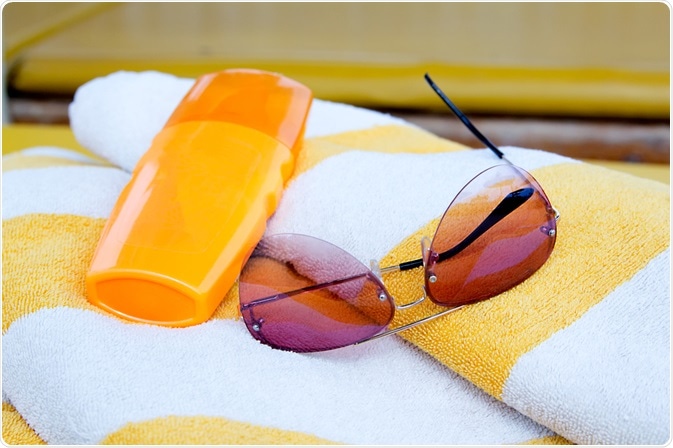Although spending time outdoors has many benefits including reducing stress, offering options to be physically active, and access to vitamin D, exposing skin to the harmful rays of the sun can raise the risk of skin cancer. Most types of skin cancers result from exposure to ultraviolet (UV) light, which can penetrate to deep levels of the skin, damaging or killing skin cells. However, there are steps that can be taken to protect the skin from the damaging effects of the sun.
Reducing the risk
The most effective way to reduce the risk of skin damage and cancer is to minimize direct skin exposure to the sun:
- Clothing: Wearing clothing made from a densely woven fabric that covers the skin (such as long-sleeved tops) offers some protection from UV light. Clothing in dark colors is more effective as darker colors absorb more UV light than lighter shades, reducing the amount of UV light that can reach the skin.
- Hat: Wearing a hat with a wide brim that shades the face, ears, and neck offers the best protection.
- Sunglasses: Sunglasses protect the thin, sensitive skin surrounding the eyes, but also the eyes themselves. They can mitigate against developing cataracts which can occur if the surface of the eye becomes burned. Reflected sunlight (from water or snow) is particularly dangerous to the eyes. Even when wearing sunglasses, looking directly at the sun should be avoided, as this can cause permanent damage to the eyes.
- Shades: Avoiding direct sunlight by stays in the shade provides some protection from UV light, but sunscreen and protective clothing should still be worn.
- Sunscreen: Liberally applying sunscreen with a high sun protection factor (SPF) is important but should not be considered sufficient alone. It is most effective when combined with other sun safety precautions. To be as effective as possible, it should be reapplied frequently and used within its expiration date.

Sun Safety. Image Credit: kordeo/Shutterstock.com
What is the sun protection factor (SPF)?
The sun protection factor (SPF) is one measure of the efficacy of a given sunscreen agent and relates to the degree to which a product protects the skin from the damaging effects of ultraviolet (UV) light. UV radiation has a wide spectrum and is divided into different types of radiation, including UVA and UVB radiation. Exposure to UVA remains constant and has a cumulative effect over time, degrading elastin and collagen, and reducing elasticity.
UVB exposure is increased during the summer months and causes acute skin changes such as sunburn and pigmentation, but also chronic changes such as photocarcinogenesis. Photocarcinogenesis is the result of biochemical changes which lead to skin cancer.
SPF is a measure of the amount of protection from UVB radiation that a sunscreen product offers, measured by the amount of UVB that it absorbs. In 2011, the United States Food and Drug Administration provided a clear formula to calculate SPF. SPF was defined as the dose of UVB required to produce one minimal erythema dose (MED; the lowest dose of UV light needed to cause reddening of the skin) after the application of a sunscreen product, divided by the UV light causing MED on untreated skin.
When applied, this formula shows that an SPF of 15 correlates with 93% UVB absorption, an SPF of 30 relates to 96.7% absorption and an SPF of 50 correlates with 98% UVB absorption.
In the United Kingdom, products also receive a star rating which measures the degree of protection from UVA radiation. Ranging from 0-5, stars indicate the proportion of UVA absorbed by the product compared to UVB. As this system awards stars according to the ratio of protection from both UVA and UVB (with 5 stars indicating that UVA and UVB protection is about the same), a low SPF product can be highly starred.
Therefore, it is important to select a product with both a high SPF and high star rating. A good level of sun protection is a sunscreen with an SPF of 30 and a minimum of 4 stars.
How to apply sunscreen
Sunscreen should be applied liberally. If it is applied too thinly, it may not offer the purported amount of SPF. It should be applied to all areas of exposed skin, ideally twice: 30 minutes before sun exposure, and again before exposure.
It should be reapplied frequently, approximately every two hours, and immediately after swimming, showering, sweating, or towel drying, even if it is labeled as water-resistant.
Top sun safety tips
- Protect skin with clothing, including a hat, t-shirt, and sunglasses, and always choose a sunscreen product of at least SPF 30. Sunscreen should be applied generously and frequently.
- Ensure that you never allow the skin to burn.
- Spend time under shade during the middle part of the day when the sun is at its strongest.
- Take extra care with children and keep babies and toddlers out of direct sunlight.
References:
- Dale Wilson, B., Moon, S., & Armstrong, F. (2012). Comprehensive review of ultraviolet radiation and the current status on sunscreens. The Journal of clinical and aesthetic dermatology, 5(9), 18–23.
- Latha, M. S., Martis, J., Shobha, V., Sham Shinde, R., Bangera, S., Krishnankutty, B., Bellary, S., Varughese, S., Rao, P., & Naveen Kumar, B. R. (2013). Sunscreening agents: a review. The Journal of clinical and aesthetic dermatology, 6(1), 16–26.
- Ma, Y., & Yoo, J. (2021). History of sunscreen: An updated view. Journal of cosmetic dermatology, 20(4), 1044–1049. https://doi.org/10.1111/jocd.14004
- Anon, (2019). Sun Safety. [online] Available at: https://www.cdc.gov/cancer/skin/basic_info/sun-safety.htm.
- www.bad.org.uk. (n.d.). British Association of Dermatologists - Sunscreen Fact Sheet. [online] Available at: https://www.bad.org.uk/skin-cancer/sunscreen-fact-sheet.